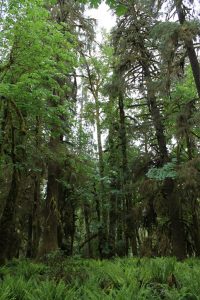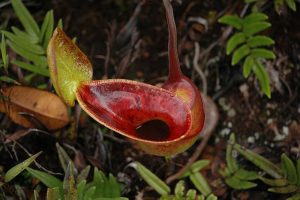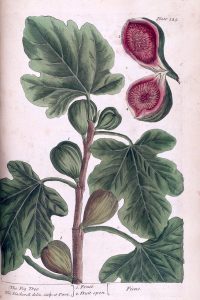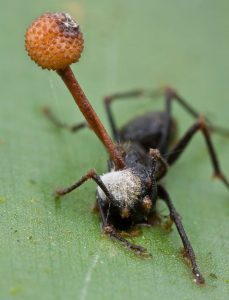By Andy Winfield

‘Survival of the fittest’ is a phrase used to describe the natural world; the spoils are to be won and the strongest live on. Life is more complicated than this, and there are many lives that endure through building partnerships and being good neighbours. New discoveries are being made all the time about the adaptations that organisms make to survive. Many of these discoveries are in the plant world; our understanding of reciprocal relationships between plants, animals and fungi is growing all the time and perhaps the natural world is more companionable than we originally thought. There are brutal elements, but all the while connections are being made, trades agreed, and reciprocal back scratching develops, aka ecological mutualism.

Plants, for the most part, are rooted in one position. They can’t run away from danger, bury themselves in the ground or fly away, they’re stuck with their neighbours. In an environment such as a forest, where light is at a premium and the diversity of life above and below ground is so dense, can every organism really be in a constant competitive battle? In recent years it has become more apparent just how reciprocal relationships in a forest really are. Exploring the dark humus of the forest floor are thin white strands of mycelium, the growing tips of fungi. Mycelium and plant roots seek each other out and latch on to each other; it is now known that nutrients and water pass along these strands from tree to tree, they don’t even have to be the same species of tree, and they share their produce to keep the network balanced. The question is, are the plants sensing the need in other plants, or is fungi controlling the health of trees like forestry puppet masters? It would be in the interest of fungi to maintain the forest. That said, some North American woodlands are known to have ‘mother trees’ that send more nutrients and water to their genetic offspring than other trees; so, is this a ‘decision’ by the tree or just a question of compatibility? There are many species of fungi having arrangements with many species of plants; the complexity of the ‘wood wide web’ is staggering and the relationships complicated. These findings are still new in terms of science, and it’s a fascinating area to keep an eye on. Highly recommended is Searching for the Mother Tree by Suzanne Simand and Entangled Life by Merlin Sheldrake to top up your learning.

Plants and animals also have some wonderful relationships. Borneo is home to several species of Nepenthes, or pitcher plant. These are plants that have hollow, tubular growths with a nectar rich rim to attract, trap, and digest insects who cross their paths, very much in the ‘survival of the fittest’ camp. Although, there are two species of pitcher plant that have developed very different relationships with mammals. Nepenthes hemsleyana has become a sleeping bag for the woolly bat; as they sleep their guano splashes in the pitcher and feeds the plant. Nepenthes lowii has a similar arrangement with tree shrews. The small mammals make themselves comfortable inside the pitcher and feed on its nectar; when the inevitable call of nature overcomes the shrew, the plant feasts on its faeces, giving the plant its unofficial name, ‘shrew loo’.
 The relationship between plants and pollinators is well known, but some plants take it to extremes. The fig for example has a pollinator that is completely reliant on it for life, and the fig for it. The unpollinated flowers of a fig are held inside their unripe fruit; a female fig wasp will burrow into the fruit from outside. Once in she’ll lay her eggs, in the process pollinating the female flowers (all will become clear, read on), before dying. The flower’s ovaries produce some seed, while on others the wasp eggs sit like a seed until male wasps emerge. These male wasps are able to fertilize the female larva before frantically digging holes to the outside world though the wall of the fruit; once the escape tunnel is complete they die. When the females emerge, they wander over flowers picking up male pollen, escape through the ready dug channels, fly to the next unripe fig, and so it goes on. The fig and the wasp are tied to each other in a never-ending cycle of regeneration and reciprocation.
The relationship between plants and pollinators is well known, but some plants take it to extremes. The fig for example has a pollinator that is completely reliant on it for life, and the fig for it. The unpollinated flowers of a fig are held inside their unripe fruit; a female fig wasp will burrow into the fruit from outside. Once in she’ll lay her eggs, in the process pollinating the female flowers (all will become clear, read on), before dying. The flower’s ovaries produce some seed, while on others the wasp eggs sit like a seed until male wasps emerge. These male wasps are able to fertilize the female larva before frantically digging holes to the outside world though the wall of the fruit; once the escape tunnel is complete they die. When the females emerge, they wander over flowers picking up male pollen, escape through the ready dug channels, fly to the next unripe fig, and so it goes on. The fig and the wasp are tied to each other in a never-ending cycle of regeneration and reciprocation.
 Of course, nature has many relationships where one of the participants is more equal than the other; this, from Merlin Sheldrake’s Entangled Life has been an ongoing ‘relationship’ for 48 million years…
Of course, nature has many relationships where one of the participants is more equal than the other; this, from Merlin Sheldrake’s Entangled Life has been an ongoing ‘relationship’ for 48 million years…
“’Zombie fungi’ are able to modify their host’s behaviour in ways that bring a clear benefit: by hijacking an insect, the fungus is able to disperse its spores and complete its life cycle. Ophiocordyseps unilateralis organises its life around carpenter ants. Once infected by the fungus, ants are stripped of their instinctive fear of heights, leave the relative safety of their nests and climb up the nearest plant. In due course the fungus forces the ant to clamp its jaws around the plant in a ‘death grip’. Mycelium grows from the ants feet and stitches them to the plant’s surface. The fungus then digests the ant’s body and sprouts a stalk out of its head, from which spores shower down on ants passing below.”
Yikes!
So, in conclusion, nature is nurturing and brutal in equal measure, a survival of the fittest and survival of the most philanthropic. Our competitive philosophy isn’t going to last as long as 48 million years at this rate; a big cultural shift to environmental generosity seems a long way off at the moment, but the young people of today are beginning to think in these terms and that can only be good.

